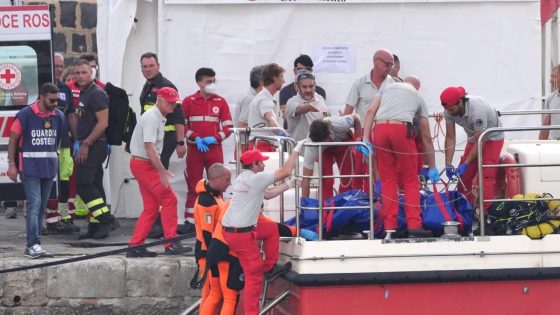Key Points
- Five bodies, including that of Mike Lynch, have been recovered after a luxury yacht capsized off Sicily.
- The precise cause of the sinking is still unknown, as is the whereabouts of one passenger.
- Fifteen people were rescued and eight hospitalised after a storm struck the 56m yacht.
The body of British tech magnate Mike Lynch has been retrieved from the wreck of his family yacht that sank off the coast of Sicily during a violent storm, a source close to the rescue operation says.
Lynch’s 18-year-old daughter Hannah is still unaccounted for, the source said.
The bodies of the other four people who vanished when the boat went down were recovered from the yacht on Wednesday.
The British-flagged Bayesian, a 56-metre superyacht carrying 22 passengers and crew, was anchored off the port of Porticello, near Palermo, when it disappeared beneath the waves in a matter of minutes after the bad weather struck.
British tech magnate Mike Lynch is reportedly among the five bodies recovered from the sunken superyacht. Source: AAP / Yui Mok
Lynch, 59, was one of the UK’s best-known tech entrepreneurs and had invited friends to join him on the yacht to celebrate his recent acquittal in a major US fraud trial.
His body was brought ashore in a blue body bag and driven in an ambulance to a nearby hospital morgue.
Besides Lynch and his daughter, the other people who failed to escape from the boat were Judy and Jonathan Bloomer, a non-executive chair of Morgan Stanley International; and Clifford Chance lawyer Chris Morvillo and his wife, Neda Morvillo.
Fifteen people, including Lynch’s wife, managed to get to safety, while the body of the onboard chef, Canadian-Antiguan national Recaldo Thomas, was found near the wreck hours after the disaster.
Specialist rescuers have been searching inside the hull of the sunken yacht for the past three days, but operations have been challenging due to the depth and the narrowness of the places that the divers are scouring, the fire brigade said.
It compared the efforts to those carried out, on a larger scale, for the Costa Concordia, the luxury cruise liner that capsized off the Italian island of Giglio in January 2012, killing 32 people.
Why did the Bayesian superyacht sink?
The disaster has baffled naval marine experts who said such a vessel, built by Italian high-end yacht manufacturer Perini and presumed to have top-class fittings and safety features, should have been able to withstand such weather.
Prosecutors in the nearby town of Termini Imerese have opened an investigation and authorities have started questioning passengers and witnesses.
The captain, James Cutfield, and his eight surviving crew members have made no public comment on the disaster.
Giovanni Costantino, CEO of the Italian Sea Group, which includes Perini, said the Bayesian was “one of the safest boats in the world” and basically unsinkable.
He said he believed the disaster was caused by a chain of human mistakes and that the storm had been expected, in interviews with Italian media.
Divers working in teams could only spend about 12 minutes at a time searching due to the wreck’s depth, which requires special precautions. Source: SIPA USA, AAP / Antonio Melita/Pacific Press
“The ship sank because it took on water, from where investigators will have to say,” Costantino told television news program TG1 late on Wednesday.
Citing data from the yacht’s automatic tracking system and based on available footage, Costantino said it took 16 minutes from when the wind began buffeting the yacht, and it began taking on water, for it to sink.
Jean-Baptiste Souppez, a fellow of the Royal Institute of Naval Architects, said: “There’s a lot of uncertainty as to whether it had a lifting keel and whether it might have been up.”
“But if it had, then that would reduce the amount of stability that the vessel had, and therefore made it easier for it to roll over on its side,” he said in an interview.
Karsten Borner, the captain of the Sir Robert Baden Powell sailboat, which came to the Bayesian’s rescue, said his craft had sustained minimal damage — the frame of a sun awning broke — even with winds that he estimated reached 12 on the Beaufort wind scale, which is the highest, hurricane-strength force on the scale.
He said he had remained anchored with his engines running to try to maintain the ship’s position as the storm, which was forecast, rolled in.
“Another possibility is to heave anchor before the storm and to run downwind at open sea,” he said in a text message.
But Borner said that might not have been a viable option for the Bayesian, given its trademark 75-metre tall mast.
“If there was a stability problem, caused by the extremely tall mast, it would not have been better at open sea,” he said.
Yachts like the Bayesian are required to have watertight sub-compartments that are specifically designed to prevent a rapid, catastrophic sinking even when some parts fill with water.
“So for the vessel to sink, especially this fast, you are really looking at taking water on board very quickly, but also in a number of locations along the length of the vessel, which again indicates that it might have been rolled over on its side,” Souppez said.




